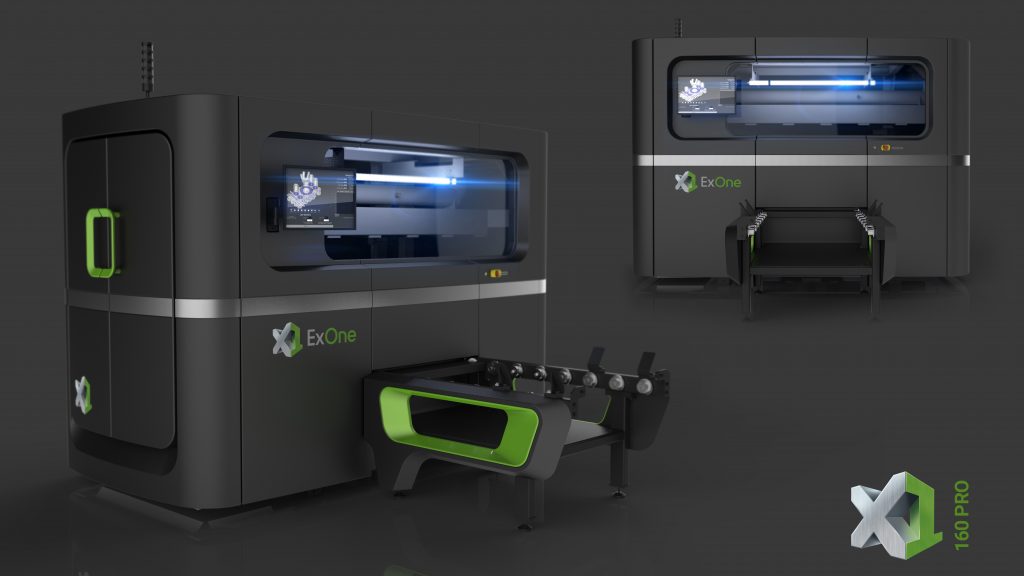As a binder jet additive manufacturing specialist, ExOne has expertise ranging across a variety of different materials. Working with sand, the company has become well established in the investment casting industry, providing a custom solution for the production of core tooling. On the other hand, with its metal 3D printing capabilities, ExOne is providing its customers with geometric flexibility and precision that exceeds the capabilities of investment casting.
Today, almost half the installed base of ExOne 3D printers around the world are metal binder jetting machines. For the manufacture of end-use parts, this includes the new production X1 25PRO, which is shipping to customers this quarter, and the X1 160PRO, which was announced this month. At the other end of the spectrum, the Innovent+ is regularly applied to R&D, prototyping and material development projects.
Now, fulfilling the industry’s growing demand for metal 3D printing in production, ExOne has released the X1 160PRO, the company’s largest machine yet with a build envelope measuring 800 x 500 x 400 mm or 160 liters, thus the name.
Comparing binder jet to where ExOne started over 20 years ago, it is plain to see just how far the 3D printing industry has progressed.
The foundations of ExOne metal 3D printing
ExOne is rooted in the early 1990s ProMetal division of Extrude Hone Corp. Through this division, Extrude Hone began exploring opportunities in metal 3D printing as early as 1995. The following year, the company obtained an exclusive license to an inkjet 3D printing process patented by researchers at the Massachusetts Institute of Technology (MIT). Building on the MIT approach, Extrude Hone released its first commercial efforts in the metal 3D printing space in 1998, debuting the ProMetal RTS-300.
The technology used in the ProMetal RTS-300 is the very same method that forms the basis of ExOne’s metal 3D printers today. Now onto its tenth metal 3D printer with the X1 160PRO, over the years ExOne has made vital technical developments, taking into account customer feedback and continued internal use.
In 2002, years after the initial development of metal 3D printer, Extrude Hone made its first entry into the sand 3D printing market. In the three years after this, the company would be re-established as ExOne as we know it today, following a strategic asset transfer by the late founder Larry Rhoades.

Prototyping, series production and parts on demand
As the founder of Extrude Hone, Rhoades sold the company to Kennametal in 2005, retaining only the assets of the ProMetal division’s 3D printing business. Believing strongly in the potential of 3D binder jetting, Rhoades then transferred these assets over to The Ex One Company LLC in the same year, naming the company in tribute to the sold Extrude Hone.
Following Rhoades’ untimely death in 2007, The Ex One Company LLC was purchased by current Chairman of the Board S. Kent Rockwell. In 2013, it changes its name to The ExOne Company, and it completed a successful IPO on the Nasdaq.
Today, metal 3D printing still forms a core portion of ExOne’s business. Of the seven 3D printers currently forming ExOne’s system portfolio, four are metal machines. Growing in capabilities (and often in size) with every new generation, the company is committed to supporting the gamut of 3D printing applications with its products: from prototyping to series production, and parts on demand.
For a hands-on look at some of the latest ExOne 3D printers, visitors to Formnext 2019 are invited to the company booth in hall 12.0 stand C21.
The full range of ExOne metal and sand 3D printers can also be found online here.
For all of the latest news and releases from Formnext 2019 and more subscribe to our newsletter for the latest additive manufacturing business news. You can also stay connected by following us on Twitter and liking us on Facebook. Looking for a career in the industry? Visit 3D Printing Jobs for a selection of current roles.
Featured image shows a metal 3D printed torque converter. Photo via ExOne


